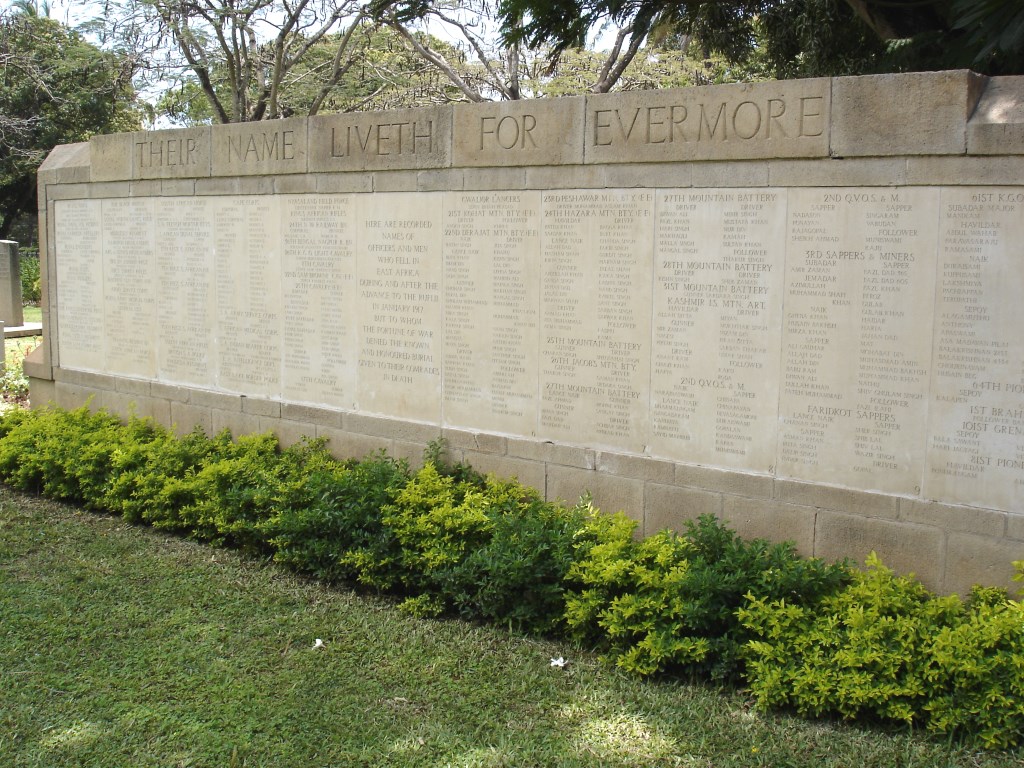Dar Es Salaam British And Indian Memorial
- Country Tanzania
- Total identified casualties 1530 Find these casualties
- Identified casualties from First World War
- GPS Coordinates Latitude: -6.77431, Longitude: 39.24468
Historical Note
 This combined British-Indian memorial to the missing, unveiled in the 1920s, originally included on its panels the names of all British personnel and Indian officers. The Indian non-commissioned officers and other ranks were commemorated numerically, with their names included in a memorial register. In 2004 the panels on this memorial were corrected to include the names of all those it was built to commemorate.
This combined British-Indian memorial to the missing, unveiled in the 1920s, originally included on its panels the names of all British personnel and Indian officers. The Indian non-commissioned officers and other ranks were commemorated numerically, with their names included in a memorial register. In 2004 the panels on this memorial were corrected to include the names of all those it was built to commemorate.
You can find more information about historical inequalities in commemoration in our Special Committee’s report.
Read the Non-Commemoration report
>
Location information
This Memorial is situated in Memorial Garden 'A' in Dar Es Salaam War Cemetery.
Dar Es Salaam War Cemetery is located on the right (eastern/coastal) side of Bagamoyo Road, which heads north-west along the coast from the centre of Dar-Es-Salaam and is clearly marked.
The cemetery is about 5 kilometres from the city centre, and a roadside direction sign indicates the turn off for Bagamoyo Road into the lane leading to the cemetery.
Visiting information
ARRIVAL
The route to the cemetery is signposted.
PARKING
Layby parking close to the cemetery entrance. From the main road a track 150 – 200 metres runs through trees up to the main entrance.
The ground surface of the parking area is firm, a mixture of loose gravel on a scrubland, dirt track.
ACCESS, LAYOUT AND MAIN ENTRANCE
The cemetery is rectangular shaped.
The main entrance gate is metal, low level (mid-thigh height) and approximately 4 metres wide. The opening section is 2 metres wide. Each section rotates on a post to create openings into the cemetery.
There is a small lip step approximately 10 centimetres in depth from the ground level path, up to paving slabs close to the gate at the main entrance. The paving slabs at the junction of the entrance feature and grass are uneven and slightly lower than the grass.
The main burial plots are on the left side and towards the centre of the cemetery with 6 Memorial Gardens on the right-hand side, along with more burial plots.
The Cross of Sacrifice is in the centre of the cemetery.
There are stone bench seating areas in the cemetery.
The internal cemetery paths are grass, the ground surface is firm and flat.
The Register Box is built into the wall at the main entrance.
ALTERNATIVE ACCESS
The alternative entrance is through the cemetery service entrance. The service entrance has two 2- metre wide gates which open inwards. There is a small concrete lip at the gates. The route to the service entrance is signposted from the main entrance.
ADDITIONAL INFORMATION
The cemetery is open every day from 0600 hrs to 1800 hrs.
Among the Memorial Gardens are two large memorial walls:
Dar Es Salaam Hindu Cremation Memorial
Dar Es Salaam British and Indian Memorial.
History information
Dar es Salaam, now the capital of Tanzania, was at the outbreak of the First World War the capital of German East Africa. It stands at the side of an almost land-locked harbour. The Germans made it the terminus of the Central Railway, which was built by them and which extended to the shores of Lake Tanganyika. It was bombarded by a British squadron on the 14th August 1914. It surrendered to British naval and military forces on the 3rd September 1916 and No.3 East African Stationary Hospital was placed in the town, which then became the chief sea base for supplies and for the evacuation of sick and wounded. From the invasion of April 1915, Commonwealth forces fought a protracted and difficult campaign against a relatively small but highly skilled German force under the command of General von Lettow-Vorbeck. When the Germans finally surrendered on 23 November 1918, twelve days after the European armistice, their numbers had been reduced to 155 European and 1,168 African troops.
The DAR ES SALAAM BRITISH AND INDIAN MEMORIAL which stands within Dar es Salaam War Cemetery, commemorates by name more than 1,500 officers and men who died in East Africa during and after January 1917 (the advance to the Rufiji river) who have no known grave. The memorial was moved from a site elsewhere in the township and re-sited in Memorial Garden A. The earlier casualties are commemorated by a similar memorial at Nairobi, Kenya.
DAR ES SALAAM WAR CEMETERY was created in 1968 when the 660 First World War graves at Dar Es Salaam (Ocean Road) Cemetery had to be moved to facilitate the construction of a new road. As the burials in the three former plots had not been marked individually, they were reburied in collective graves, each marked by a screen wall memorial. (Memorial Gardens "B", "C" and "D"). During the early 1970s, a further 1,000 graves were brought into this site from cemeteries all over Tanzania, where maintenance could no longer be assured.
Dar es Salaam War Cemetery now contains 1,770 Commonwealth burials of the First World War, 67 of them unidentified, and 34 from the Second World War. The 112 war graves of other nationalities, the majority of them Belgian and German, all date from the First World War.
The cemetery also contains the DAR ES SALAAM HINDU CREMATION MEMORIAL which commemorates 14 Indian servicemen whose remains were cremated in accordance with their faith.



